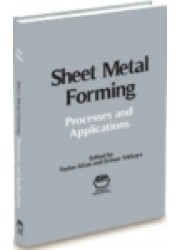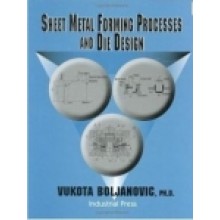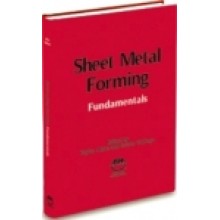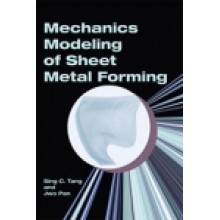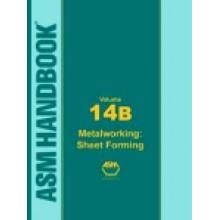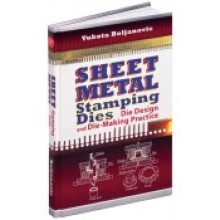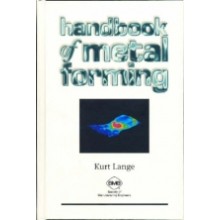Sheet Metal Forming Processes and Applications
Our Price: $175.00
Discount : 12%
Quantity:
-
Add to Compare
Contents
Chapter 1: Blanking
1.1 Blanking Process
1.2 Forces and Stresses
1.3 Part Edge Characteristics
1.4 Effects of Tooling and Presses
1.5 Tool Materials
1.6 Ultra-High-Speed Blanking
1.7 Fine Blanking
1.8 Shearing
1.9 Finite-Element Simulations
Chapter 2: Bending, Flanging, and Hemming
2.1 Mechanics of Bending
2.2 Air Bending
2.3 Stretch Bending
2.4 Other Industrial Bending Processes
2.5 Contour and Hole Flanging
2.6 Hemming
2.7 Bending Machines
2.8 Other Bending Machines
Chapter 3: Process Simulation
3.1 Advantages of Process Simulation
3.2 Commercial Codes for Forming Simulations
3.3 Steps Involved in FEM Simulations
3.4 Case Studies in Sheet Metal Forming
3.5 Factors Affecting the Accuracy of FEM Simulations
Chapter 4: Progressive and Transfer Die Forming
4.1 Process Design Using Finite-Element Analysis
4.2 Application of FEA in Progressive Die Design
Chapter 5: Warm Forming of Magnesium and Aluminum Alloys
5.1 Mechanical Behavior and Testing Methods
5.2 Warm Forming Process
5.3 Applications of Warm Forming
5.4 Deep Drawing
Chapter 6: Forming of Advanced High-Strength Steels (AHSS)
6.1 Mechanical Behavior of AHSS
6.2 Forming of AHSS
6.3 Tribology in Forming AHSS
6.4 Presses and Tooling
6.5 Springback
Chapter 7: Hot Stamping
7.1 Significant Process Variables
7.2 Material Flow and Process Simulation
7.3 Finite-Element Simulation of Hot Stamping
7.4 Heating Methods
7.5 Tools (Dies) for Hot Stamping
7.6 Coatings for Oxidation Prevention
7.7 Other Areas of Importance
Chapter 8: Sheet Hydroforming
8.1 The Room-Temperature Sheet Hydroforming System
8.2 Process Description, Advantages, and Disadvantages
8.3 Advantages and Disadvantages
8.4 Sheet Hydroforming—Process Variations
8.5 Sheet Hydroforming Presses
8.6 Tool Design
8.7 Process Limits, Defects, and Process Window in SHF-P
8.8 Process Simulation: Room-Temperature Sheet Hydroforming
8.9 Elevated-Temperature Sheet Hydroforming
8.10 Industrial Applications of Sheet Hydroforming
8.11 Sheet Hydroforming Process Economics
Chapter 9: Tube Hydroforming
9.1 Applications
9.2 Tube Hydroforming as a System
9.3 Materials for Tube Hydroforming
9.4 Tube Bending
9.5 Mechanics of Tube Hydroforming
9.6 Friction and Lubrication in Tube Hydroforming
9.7 Presses and Tooling
9.8 Tube Hydroforming Process Design and Design Guidelines
Chapter 10: Roll Forming
10.1 Roll Forming Lines
10.2 Roll Design
10.3 Recent Developments and the Future of Roll Forming Technology
10.4 Future of Roll Forming
Chapter 11: High-Velocity Forming
11.1 High-Velocity Hydroforming
11.2 High-Velocity Mechanical Forming
11.3 Electromagnetic Forming
Chapter 12: Spinning, Shear Forming, and Flow Forming
12.1 Spinning
12.2 Flow Forming
12.3 Shear Spinning
Chapter 13: Incremental Sheet Forming
13.1 Process Variations of ISF
13.2 Equipment and Basic Process Parameters
13.3 Process Mechanics and Process Limits
13.4 Multistage Forming Strategies
13.5 Process Modeling
13.6 Hybrid Process Variations
Chapter 14: Mechanical Joining by Forming
14.1 Riveting
14.2 Clinching
14.3 Future Trends
14.4 Fatigue Behavior of Clinched Joints
14.5 Crimping
Chapter 15: Sensors for Sheet Metal Forming
15.1 Measurement of Forces
15.2 Displacement Sensors
15.3 Detection of Tool Breakage and Flaws in Parts
15.4 Measurement of Material Flow during Forming
15.5 Machine Vision Systems
15.6 Online Material Property Evaluation
15.7 Sensors for Lubrication
15.8 Summary
Chapter 16: Tool Materials, Treatments, and Coatings
16.1 Background
16.2 Tool Materials
16.3 Treatments to Harden the Tools
16.4 Plating and Coating
16.5 Galling/Wear Tests
16.6 Guidelines for Selecting Tool Materials, Treatments, and Coatings
Index
Write a review
Your Name:Your Review: Note: HTML is not translated!
Rating: Bad Good
Enter the code in the box below:
Copyright © 2014 Engineering Standards Bureau. All Rights Reserved.
Developed By Zoom Into Web


